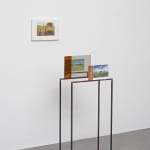Juan Araujo
N. 1971, Caracas, Venezuela
Vive e trabalha em Porto, Portugal
Eu também vivi em Arcadia, 2021
óleo sobre tela; oil on copper
[oil on canvas; oil on copper]
[oil on canvas; oil on copper]
base [plinth]: 91 x 50 x 50 cm | 35 7/8 x 19 3/4 x 19 3/4 in
lâmina cobre I [copper sheet I]: 33,2 x 25 cm | 13 x 9 7/8 in
lâmina cobre I [copper sheet II]: 16,7 x 25 cm | 6 1/4 x 9 7/8 in
pintura base [painting on plinth] 24 x 35 cm | 9 1/2 x 13 3/4 in
pintura na parede [work on the wall]: 24 x 35 cm | 9 1/2 x 13 3/4 in
lâmina cobre I [copper sheet I]: 33,2 x 25 cm | 13 x 9 7/8 in
lâmina cobre I [copper sheet II]: 16,7 x 25 cm | 6 1/4 x 9 7/8 in
pintura base [painting on plinth] 24 x 35 cm | 9 1/2 x 13 3/4 in
pintura na parede [work on the wall]: 24 x 35 cm | 9 1/2 x 13 3/4 in
17749
© artista [the artist]
Further images
-
(View a larger image of thumbnail 1
)

-
(View a larger image of thumbnail 2
)

-
(View a larger image of thumbnail 3
)

-
(View a larger image of thumbnail 4
)

-
(View a larger image of thumbnail 5
)

-
(View a larger image of thumbnail 6
)

-
(View a larger image of thumbnail 7
)

-
(View a larger image of thumbnail 8
)

Eu vivi, também, na Arcádia, célebre frase de um poema bucólico das “Éclogas" (c. 39–38) de Virgílio, é o título da nova série de pinturas do artista venezuelano Juan Araujo especialmente concebidas para a exposição coletiva O Canto do Bode na Casa da Cultura da Comporta.
As pinturas, assentes num plinto desenhado pelo arquiteto Manuel Aires Mateus, mostram a reprodução de uma imagem da Casa em Monsaraz (2007-2009) – projeto do atelier Aires Mateus que reinventa a poética da gruta e da noção de arquitetura como abrigo/refúgio –, em diálogo com um dos testemunhos mais imponentes da presença do megalitismo funerário em Portugal, a Anta de Melriça em Castelo de Vide. Ao fundo, na parede, uma pintura feita a partir de um postal antigo na qual se vê um pastor alentejano sentado em profunda melancolia, remete-nos para a ideia de fantasia pastoral, de uma utopia perdida e de um mundo prestes a desaparecer. Esta nova série de pinturas, traz uma das temáticas mais debatidas pela cultura e história da arte ocidentais – refira-se, por exemplo, os pintores Nicolas Poussin (1594-1665) e Claude Lorrain (1600-82) –, e que se relaciona com a evolução da construção mental da Arcádia ao longo dos tempos e a sua relação dicotómica com a ideia de lugar/sítio e arquitetura. Existe arquitetura sem lugar? É possível existir um lugar utópico sem intervenção material ou mental? Terá a noção de ruína na modernidade perpassado um sentido de destruição, perda, abandono, memória e se convertido numa projeção imaginativa do passado?
[I also lived in Arcadia, a famous phrase from a bucolic poem from Virgílio's “Eclogas” (c. 39–38), is the title of the new series of paintings by Venezuelan artist Juan Araujo specially conceived for the group exhibition O Canto do Goat at Comporta's House of Culture.
The paintings, based on a plinth designed by architect Manuel Aires Mateus, show the reproduction of an image of the House in Monsaraz (2007-2009) – a project by the Aires Mateus studio that reinvents the poetics of the cave and the notion of architecture as a shelter/refuge – , in dialogue with one of the most imposing testimonies of the presence of funerary megalithism in Portugal, the Melriça Tapir in Castelo de Vide. In the background, on the wall, a painting made from an old postcard in which an Alentejo shepherd sits in a deep melancholy, reminds us of the idea of pastoral fantasy, a lost utopia and a world about to disappear. This new series of paintings brings one of the most debated themes in Western culture and art history – refer, for example, to the painters Nicolas Poussin (1594-1665) and Claude Lorrain (1600-82) – and which is related with the evolution of Arcadia's mental construction over time and its dichotomous relationship with the idea of place/site and architecture. Is there architecture without a place? Is it possible for a utopian place to exist without material or mental intervention? Has the notion of ruin in modernity permeated a sense of destruction, loss, abandonment, memory and converted into an imaginative projection of the past?]
Luisa Strina Mailing List
Inscreva-se
* denota campos obrigatórios
We will process the personal data you have supplied to communicate with you in accordance with our Políticas de Privacidade. You can unsubscribe or change your preferences at any time by clicking the link in our emails.







